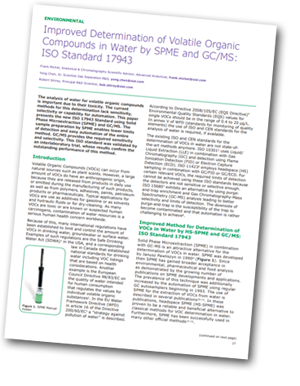Volatile Organic Compounds (VOCs) can occur from natural sources such as plant scents. However, a large amount of VOCs do have an anthropogenic origin, because they are released from products in daily use or emitted during the manufacturing of such products, as well as from polymers, adhesives, paints, petroleum products or pharmaceuticals. Typical applications for VOCs are use as additives for gasoline or as solvents and hydraulic fluids or for dry-cleaning. As many VOCs are toxic or are known or suspected human carcinogens, contamination of water resources is a serious human health concern worldwide.
 Because of this, many international regulations have been established to limit and control the amount of VOCs in drinking water, groundwater or surface water. Examples of such regulations are the Safe Drinking Water Act (SDWA) in the USA, and a corresponding law in Canada that established national standards for drinking water including VOC listings that are based on health considerations. Another example is the European Council Directive 98/83/EC on the quality of water intended for human consumption that regulates the values for individual volatile organic substances. In the EU Water Framework Directive (WFD) in article 16 of the Directive 200/60/EC a “strategy against pollution of water” is described. According to Directive 2008/105/EC (EQS Directive) Environmental Quality Standards (EQS) values for single VOCs should be in the range of 0.4 to 20 μg/L. In annex V of WFD (standards for monitoring of quality elements) the use of ISO and CEN standards for the analysis of water is required, if available.
Because of this, many international regulations have been established to limit and control the amount of VOCs in drinking water, groundwater or surface water. Examples of such regulations are the Safe Drinking Water Act (SDWA) in the USA, and a corresponding law in Canada that established national standards for drinking water including VOC listings that are based on health considerations. Another example is the European Council Directive 98/83/EC on the quality of water intended for human consumption that regulates the values for individual volatile organic substances. In the EU Water Framework Directive (WFD) in article 16 of the Directive 200/60/EC a “strategy against pollution of water” is described. According to Directive 2008/105/EC (EQS Directive) Environmental Quality Standards (EQS) values for single VOCs should be in the range of 0.4 to 20 μg/L. In annex V of WFD (standards for monitoring of quality elements) the use of ISO and CEN standards for the analysis of water is required, if available.
The existing ISO and CEN standards for the determination of VOCs in water are not state-of-the-art methods anymore. ISO 10301 uses Liquid/Liquid Extraction (LLE) in combination with Gas Chromatography (GC) and detection using Flame Ionization Detection (FID) or Electron Capture Detection (ECD). ISO 11423 employs headspace (HS) sampling in combination with GC/FID or GC/ECD. For certain relevant VOCs, the required limits of detection cannot be achieved using these ISO standards because the detectors are not sensitive or selective enough. ISO 15680 exhibits an alternative by using purge-and-trap enrichment and Gas Chromatography-Mass Spectrometry (GC-MS) analysis leading to better selectivity and limits of detection. The downside of purge-and-trap is the susceptibility of the trap to become contaminated and that automation is rather challenging to achieve.
This paper presents the new ISO 17943 Standard using Solid Phase Microextraction (SPME) and GC/MS. The sample preparation by SPME enables lower limits of detection and easy automation of the entire method. GC/MS provides the required sensitivity and selectivity. This ISO standard was validated by an interlaboratory trial, whose results confirm the outstanding performance of this method.




